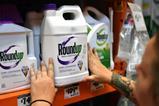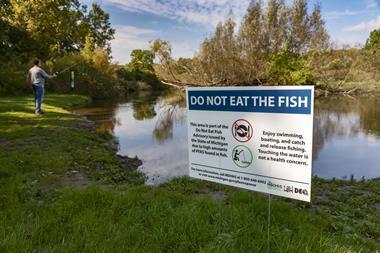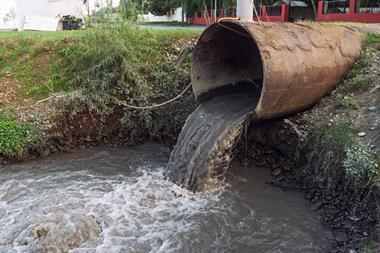The Trump administration has rolled back the US’s first legally enforceable national drinking water limits for six per- and polyfluoroalkyl substances (PFAS), which were established in April 2024 under former President Biden. An outcry followed from researchers in the field, as well as environmental advocates, concerned by what this would mean for public health and the environment.
The Environmental Protection Agency (EPA) announced on 14 May that it had delayed national drinking water regulations for the two most well-known of these substances – perfluorooctanoic acid (PFOA) and perfluorooctane sulfonic acid (PFOS) – and was repealing them for four other PFAS.
PFAS – also known as ‘forever chemicals’ – are a family of an estimated 15,000 synthetic chemicals that have been widely used in consumer products globally since the 1950s. They all share a characteristic carbon chain with multiple fluorine atoms attached. They do not degrade easily in the environment because the carbon–fluorine bond is among the strongest in existence. The unique properties of these substances confer characteristics like repellence to oil, grease and water, as well temperature resistance and friction reduction. This helps to create products that are non-stick and stain-resistant, for example.
However, PFAS are also highly mobile in the environment and they bioaccumulate, as well as biomagnify, up the food chain. PFOA and PFOS – the best studied of these substances – have been linked to serious health conditions like reproductive and developmental disorders, reduced immune function and certain types of cancer.
Under the Biden rule, the EPA set country-wide standards known as maximum contaminant levels (MCLs) for these PFAS in drinking water. The regulation applied limits of 4 parts per trillion (ppt) for PFOA and PFOS, as well as 10 ppt for perfluorohexane sulfonate (PFHxS), perfluorononanoic acid (PFNA), perfluorobutane sulfonate (PFBS) and hexafluoropropylene oxide-dimer acid (HFPO-DA), also known as GenX. It also set a ‘hazard index’ for mixtures of various PFAS to account for combined exposure to several of these compounds.
The Biden rule gave public water systems until 2029 to comply with the new MCLs, but now Trump’s EPA has pushed that compliance date back to 2031.
Postponing compliance for PFOA and PFOS will add another two years of exposure to those who use public water systems that exceed current MCLs, warns Jamie DeWitt, an environmental and molecular toxicologist at Oregon State University who has studied PFAS and their health effects extensively.
DeWitt maintains that the scientific data underscoring the MCLs for these PFAS is based on the best available science and has been evaluated by the EPA’s PFAS Science Advisory Board, of which she was a member. ‘There is no scientific reason to reverse MCLs for these four PFAS and reversing MCLs for these four PFAS will mean continued exposure to these four PFAS at or above levels that are protective of public health,’ she tells Chemistry World.
Will Dichtel, an organic chemist who studies PFAS at Northwestern University in Illinois, is relieved that the PFOA and PFOS limits have been left intact, but he is disappointed that the administration has eliminated the ‘hazard matrix’ framework for regulating the other four PFAS. ‘The 2024 rules set out to regulate the allowable combined concentrations of these four compounds,’ Dichtel states. ‘It’s taken decades for us to regulate just these few PFAS pollutants (out of thousands), so this policy change is a tremendous setback to common sense water stewardship.’
The EPA appears to be ignoring the science indicating that PFAS chemicals, other than PFOA and PFOS, are prevalent in the nation’s water systems and are similarly toxic, says Graham Peaslee, a physicist at Notre Dame University in Indiana who has published numerous studies on detecting PFAS in everything from textiles to feminine hygiene products and smartwatch wristbands.
‘One could make the case that PFBS is less toxic, but PFNA, PFHxS and GenX all have lots of toxicology data that shows toxicity at much the same level as PFOA and PFOS, so to ignore those compounds for now seems short-sighted at best,’ Peaslee states. ‘In reality, there are many other PFAS that we are discovering in our drinking water sources, so the regulations should be expanding to account for the newer species found in our water, as they are in Europe and other countries.’
Not unsurprisingly, environmental organisations also expressed significant concern. ‘The EPA’s plan to retain but delay standards for two legacy ‘forever chemicals’ may offer modest consolation to some, but throwing out protections against four others will be devastating,’ stated Erik Olsen, senior strategic director of health at the Natural Resources Defense Council. ‘The law is very clear that the EPA can’t repeal or weaken the drinking water standard. This action is not only harmful, it’s illegal,’ he added.
The EPA’s walkback of PFAS regulation came only days after the agency delayed a significant reporting rule for PFAS manufacturers, citing concerns about the costs of data submission. And just two weeks previously, the agency’s administrator, Lee Zeldin, announced actions to prevent PFAS pollution that included implementing a PFAS testing strategy under the Toxic Substances Control Act that regulates new and existing chemicals in the US.

















No comments yet